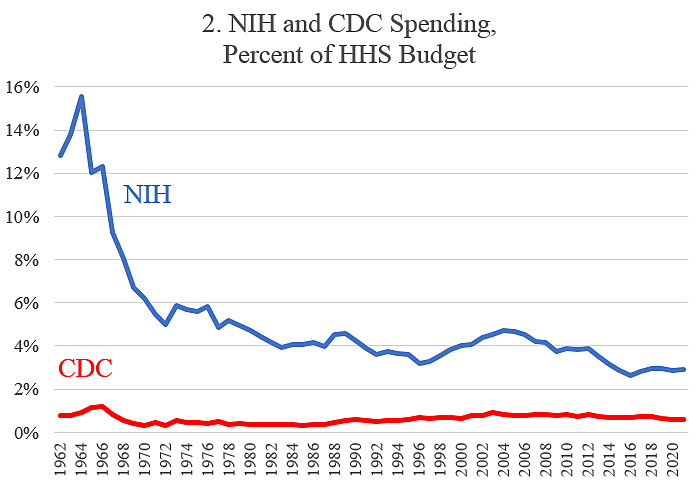"The rapid spread of coronavirus (Covid‐19) is focusing attention on the health agencies that are helping to fight the pandemic. This year, the National Institutes of Health (NIH) will spend about $38 billion on research and the Centers for Disease Control and Prevention (CDC) will spend about $8 billion on controlling infectious diseases and other activities.
The health agency budgets have become a political football in recent weeks with various claims being made regarding spending levels under President Trump. Let’s look at some data.
Figure I shows total outlays on the NIH and CDC in real (or inflation‐adjusted) dollars since 1962. The data is from the most recent federal budget released February 10. It includes estimated spending for 2020 and Trump’s proposals for 2021. I used the budget’s deflator to convert spending to real 2020 dollars.
Real NIH spending soared from the mid‐1990s to 2011. It was then cut under President Obama but has rebounded under President Trump. Real CDC spending soared from around 1990 to 2010 but has been roughly flat since then. New legislation tackling the coronavirus will increase spending above these levels going forward.
How much should we spend on the NIH and CDC? I don’t know, but there is a stronger argument for government spending on activities that are “public goods,” which are items that create broad benefits but are underprovided by markets. NIH and CDC research into infectious disease and mobilization against pandemics probably fits this category. But other spending by these agencies is more dubious, such as spending on trying to micromanage Americans’ eating, drinking, and smoking behaviors. Also, the sorts of bloat and waste that former Senator Tom Coburn once found at the CDC are not public goods.
In defending the Trump administration’s proposed CDC budget, a spokesman said, “The $4.3 billion funds all of the CDC programs that focus on infectious disease and emergency preparedness activities … This figure reflects that the administration is prioritizing funding for infectious disease and emergency preparedness efforts at CDC, compared to non‐infectious activities, like studying the health and safety risks of infrequent bathroom breaks for taxi drivers.”
In a flippant way, the spokesman was suggesting that they are steering the CDC budget toward broad‐based public goods and away from narrow‐interest spending. The budget (p. 36) says the administration wants “to re‐focus the Center for Disease Control (CDC) on its core mission of preventing and controlling infectious diseases and other emerging public health issues, such as opioids. As such, the Budget proposes to reduce funding for non‐infectious disease activities.”
It appears (p. 447) that the main CDC activity the Trump administration proposed cutting was grants to state governments, a reform approach that always makes sense. State public health programs should be funded by state taxpayers. For 2021, Trump proposed cutting state grants, but also proposed increasing CDC staffing (p. 447).
However, let’s say that all CDC and NIH spending is for important federal public goods. That spending is only a small fraction of total Department of Health and Human Services (HHS) spending, which mainly goes toward Medicare and Medicaid subsidies. Those subsidies are not public goods. This year, NIH spending is just 2.9 percent of HHS spending and CDC spending is just 0.6 percent, as shown in Figure 2.
After the current crisis, if policymakers decide to permanently increase infectious disease spending, they should match it with cuts to the vast subsidies in the $1.4 trillion HHS budget.
Monday, April 6, 2020
Coronavirus and NIH/CDC Funding
By Chris Edwards of Cato.
Subscribe to:
Post Comments (Atom)

 "
"
No comments:
Post a Comment
Note: Only a member of this blog may post a comment.